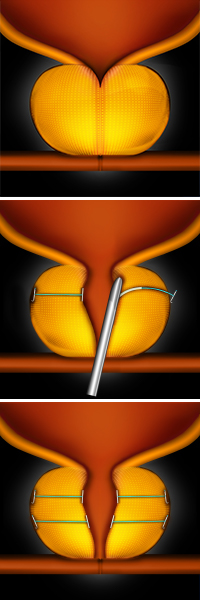NKCH has added a minimally invasive option – UroLift® – for the treatment of benign prostatic hyperplasia.
Procedure
 During the 15-minute outpatient procedure, the surgeon inserts tiny permanent implants into the obstructed urethra to relieve pressure on the enlarged prostate and thus open the urethra for symptom relief.
During the 15-minute outpatient procedure, the surgeon inserts tiny permanent implants into the obstructed urethra to relieve pressure on the enlarged prostate and thus open the urethra for symptom relief.
The procedure, which is typically recommended for men who have prostates 80 grams, involves cystoscopically inserting a transuretheral scope (see graphic, at right), said Kenneth P. Collins, MD, a urologist with Kansas City Urology Care. He gently moves the obstructing prostate tissue out of the way to open the urethra. Through a fine 19-gauge needle, he deploys an implant to hold back one side of enlarged prostate tissue. He repeats the technique on the other side of the prostate.
The number of implants needed depends on the size of the prostate and the degree of the obstruction, but four to five implants may be used. Once complete, he removes the scope. “Universally, my patients have done well and are very pleased after the procedure,” Dr. Collins said.
Patient Satisfaction
An estimated 75% of men have lower urinary tract symptoms suggestive of benign prostatic hyperplasia by age 50 years, and the percentage increases to 90% by age 85. Those symptoms include a hesitant, weak or dribbling urine stream; nocturia; and an inability to completely void.
Dr. Collins noted some patients do not find relief from the first line of defense – alpha blockers and 5-alpha-reductase inhibitors that relax and shrink the prostate. Additionally, some men experience side effects from the medication, such as a decrease in blood pressure, as well as ejaculatory and erectile dysfunction.
“If men have symptoms, but they cannot tolerate the medications or they have an interest in getting off their medications, this is a good option for them,” Dr. Collins recommended. “Some men have burning with urination and frequent urination for a week or two after surgery, but otherwise the majority of men typically don’t require going home on a catheter. Most men quickly resume normal activity.”
Research
Dr. Collins pointed to five-year data from a multi-center, randomized trial showing rapid improvement and durable relief, published in the June 2017 issue of The Canadian Journal of Urology.
Researchers looked at 206 patients, who were >50 at 19 centers in North America and Australia. Patients experienced improvements with minimal use of a postoperative urinary catheter, a rapid return to normal activity, and preservation of erectile and ejaculatory function.

Kenneth P. Collins, MD
Dr. Collins earned his medical degree from the University of Toledo Medical College. After he completed internships in internal medicine and general surgery, he was a resident in urological surgery at the Medical College of Virginia.